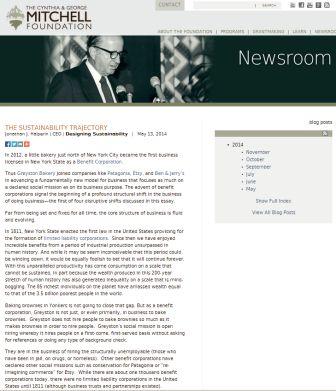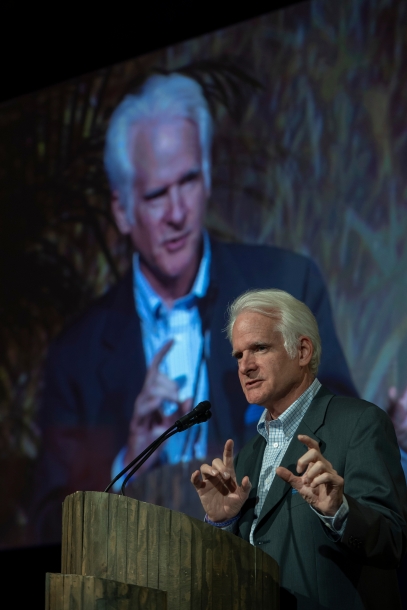You are here
The Sustainability Trajectory
The Sustainability Trajectory
In 2012, a little bakery just north of New York City became the first business licensed in New York State as a Benefit Corporation.
Thus Greyston Bakery joined companies like Patagonia, Etsy, and Ben & Jerry’s in advancing a fundamentally new model for business that focuses as much on a declared social mission as on its business purpose. The advent of benefit corporations signal the beginning of a profound structural shift in the business of doing business—the first of four disruptive shifts discussed in this essay.
Far from being set and fixed for all time, the core structure of business is fluid and evolving.
In 1811, New York State enacted the first law in the United States providing for the formation of limited liability corporations. Since then we have enjoyed incredible benefits from a period of industrial production unsurpassed in human history. And while it may be seem inconceivable that this period could be winding down, it would be equally foolish to bet that it will continue forever. With this unparalleled productivity has come consumption on a scale that cannot be sustained, in part because the wealth produced in this 200-year stretch of human history has also generated inequality on a scale that is mind-boggling. The 85 richest individuals on the planet have amassed wealth equal to that of the 3.5 billion poorest people in the world.
Baking brownies in Yonkers is not going to close that gap. But as a benefit corporation, Greyston is not just, or even primarily, in business to bake brownies. Greyston does not hire people to bake brownies so much as it makes brownies in order to hire people. Greyston’s social mission is open hiring whereby it hires people on a first-come, first-served basis without asking for references or doing any type of background check.
They are in the business of hiring the structurally unemployable (those who have been in jail, on drugs, or homeless). Other benefit corporations have declared other social missions such as conservation for Patagonia or “re-imagining commerce” for Etsy. While there are about one thousand benefit corporations today, there were no limited liability corporations in the United States until 1811 (although business trusts and partnerships existed).
Benefit corporations are of course not the only mechanism through which a business can demonstrate its commitment to socially responsibly behavior. Corporate sustainability reports and corporate foundations often expound on the “good works” being done in the communities in which they operate. But these efforts are often isolated from business operations, relatively inconsequential to the business financially, and not factors in internal business decision-making.
The benefit corporation model pulls responsibility for the social and environmental elements of the triple-bottom line out of philanthropic giving and sets it squarely in the executive suite—embedding those considerations in the core product or service of the business.
Benefit corporations thus fundamentally shift the balance of business priorities. Shareholders become just one powerful group among multiple stakeholders—practically not just rhetorically. The need to run a profitable business remains critical; no money, no mission. But the reasons for running the business are significantly expanded, as is the timeline against which success is measured.
A second disruptive structural change on the sustainability horizon is a shift in the basis for executive compensation. While the data remains somewhat opaque around this issue, what is unmistakably clear is that many more Chief Executive Officers sign eloquent and heartfelt letters to introduce sustainability reports every year. But they rarely actually put their compensation on the line to achieve sustainability goals.
According to a new CERES report, a scant 3% of 613 large publicly traded American companies link executive compensation to anything more than mere regulatory compliance on sustainability related matters.
Sustainability reports have been central to disclosure and transparency; they have given investors and advocates a point of access and leverage; and they have enabled companies to benchmark against best practices. But they have not, generally, worked their way onto the C-suite decision-making dashboard. Sustainability data, painstakingly collected and analyzed, rarely forms the basis for core business decisions. That would change—and fast—if leadership compensation was as closely linked to sustainability metrics (from water and GHG emissions, to community investments and labor practices) as it is to ‘making the numbers.’
As much as we need to redefine leadership, and the compensation that goes with it, so too does the notion of “supply chain” need to be reconceived. And this too will be highly disruptive for leaders and investors who cling to an outdated and narrowly circumscribed definition of the role of business being exclusively about producing products to generate near-term profits for its owners.
Once upon a time not so very long ago, what happened inside distant plants or on fields in far away lands, managed by layers of absentee investors, employing isolated workers with limited voice and even less political clout, seemed safe to ignore. But over a ten-year period, that changed dramatically.
In 1984, chemicals leaking from a Union Carbide plant in India killed thousands, and Bhopal became a household name. Five years later the Exxon Valdez ran aground and poured crude oil into Prince William Sound, tarring Exxon with the stain of corporate irresponsibility that has been impossible to remove. And for years in the 1990s, Nike was dogged by claims, and then acknowledged, that children in impoverished nations were making its shoes.
In a little anticipated shift, global businesses were forced to expand their horizons and exercise responsibility not just inside factory walls but also up and down global supply chains. But those “chains” were, and to a great extent still are, conceived of as circumscribed bands of direct inputs that flow vertically upward into products of ever increasing value.
We are now entering an age in which that band is bulging and the myriad horizontal connections at each point along the chain have also become of concern to global manufacturers. The flow of supplies is a web, an ecosystem—not a chain. The plant that makes cotton t-shirts relies on cotton grown in fields, picked by workers, sustained by nutrients and water and moved to market in myriad ways. And while a textile manufacturer may not perceive itself as being in the water business, that mindset exposes the business and its investors to immense risk if the price for cotton skyrockets due to competing demands among farmers, bottlers, other companies and citizens for access to limited water resources.
Managing the interconnected web of resources for multiple users is going to push buyers and procurement teams and their senior leadership to develop whole new skill sets and layered systems to ensure access to resources. Brute market power and dominance may temporarily forestall the day of reckoning for some corporations that cling to the notion of limited supply chain responsibility. But those that grasp the web-like quality of modern supply will likely prove more resilient and capable in the face of future challenges.
And finally, perhaps it is not really sustainability that holds the key to future prosperity across the triple-bottom line. Despite all the reporting, the deeply dedicated sustainability teams, and the efforts to build systems and software and better metrics, perhaps at the end of the day what we really should focus on is neither financial performance, nor integrated reporting, nor even the growth of the benefit corporation. Perhaps we are heading into an era in which we will begin to package these indicators into something vastly more than the sum of the parts to assess the overall health of a corporation. Whether organizational or personal, it is health that really tells us how we are doing, what we should be doing more of or less of, and how we stack up relative to others of similar type and size.
It is not a simple metric, but corporate health or wellness may be the elephant whose individual parts we have been poking at for some time without being able to fully see it for what it truly is—the underlying measure of a company’s capacity to generate value over time.
- jonathan.halperin's blog
- Log in or register to post comments


